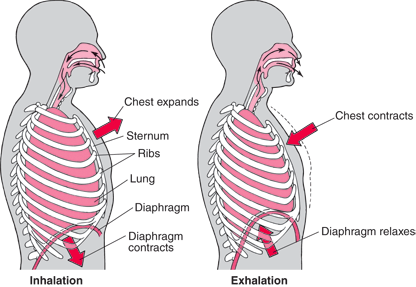Excerpts from the Tai Chi Book

Breathing Lessons
Correct breathing is the foundation of all Tai Chi practice. Why is this so? Nearly every meditative tradition in the world has identified an intimate connection between the mind and the breath. Changes in the mind and the breath reflect each other like mirrors. If someone is emotionally upset, one of the first things that happens is that their breathing becomes shallow and uneven. Conversely, if the breath is calm, deep and even, the mind reflects these qualities as well. If you want to get hold of the mind, where do you begin? Where is the mind? The mind is nowhere. It is immaterial and elusive. However, the breath gives a tangible, readily-available handle for beginning to train the mind.
In Tai Chi we use abdominal breathing. This is also known as diaphragmatic breathing. The diaphragm is the large dome-shaped muscle at the base of the rib-cage whose rising and falling is the major pump for the activity of breathing. “Abdominal breathing” means that the abdomen is completely relaxed during breathing so that the diaphragm can freely descend. This slightly increases the pressure in the abdomen during inhalation, causing it to bulge out slightly. During exhalation, the abdomen sinks back down.

The movement of the diaphragm accounts for 75 percent of the force involved in breathing. The other 25 percent is provided by the intercostals muscles (small muscles between the ribs which move the rib cage like a bellows) and the neck muscles (which help to lift the ribcage). If one uses shallow, chest breathing, the body is only breathing at ¼ of its capacity. This affects the amount of energy that the body is receiving. Studies have found that hypertensive patients, as well as people with phobias and depression tend to be chest breathers. Simply learning to habitually breath with the abdomen can help to alleviate these problems.
The Chinese also refer to the abdomen as the “second heart.” This is because two of the largest blood vessels in the body (the aorta and the vena cava) pass through the diaphragm into the abdomen. During deep abdominal breathing, the pressure inside the abdomen rhythmically increases and decreases. This creates a pumping action which can assist the heart, reducing its workload.
The Chinese also describe abdominal breathing as “bottle breathing.” When a liquid pours into a bottle, it fills the bottle from the bottom up. In the same way, we should feel the breath pouring in through the nose and filling the body form the bottom (the lower abdomen) up.
There are several simple exercises that can help you learn abdominal breathing. Once this breathing becomes habitual, you will use it in your Tai Chi practice (and your everyday) naturally and without any conscious effort. Ultimately, the breathing in Tai Chi should be natural and unforced. Besides occasionally checking to make sure that the abdomen is relaxed and gently rising and falling with the breath, one should not focus too much on the breath during Tai Chi practice. Trying to control the breath usually only results in increased tension and stress.
Exercise One: Pure Awareness of Breath
- Lie on your back. This position allows all of the postural muscles of the body to release so that there is less tension on the breathing mechanism.
- Close your eyes, take a deep breath, exhale and relax.
- Feel your forehead relax. Feel your eyes and all the muscles of your eyes relax. As your eyes relax, feel your gaze become gentler and more receptive, less intense, grasping, hard, judgmental.
- Now with this non-judgmental awareness, become aware of your breath. As you are breathing, what parts of your body can you feel moving? What is happening with your chest and ribs? Belly? Shoulders?
- Place one hand on your chest and another on your belly. Feel how the hands rise and fall with your breath.
Exercise Two: Stretching the Diaphragm
- Most people are familiar with the idea of stretching the muscles of, say, the calves or the hamstrings. However, it rarely occurs to athletes to stretch the breathing muscle before practice. The following exercises help to isolate the movement of the diaphragm in order to both stretch and strengthen it, helping it to work more easily to control the breathing.
- Lie on your back and draw up your knees so that the feet are resting flat on the floor. Move knees together and apart several times until effortless position found
- Place one hand on the lower abdomen (below the navel) and another on the chest
- Inhale, hold the breath, compress chest, directing pressure downward in the direction of the anal ring. Lower abdomen becomes round like ball and the hand over the abdomen rises. Pay attention to expanding equally in all directions, including backward, toward the floor.
- Still holding the breath, suck in the belly and feel the chest puff up as the pressure is directed upward. The hand on the abdomen rises.
- Continue this movement back and forth while holding breath. The hands should move alternately up and down like a see saw.
- It may be difficult to grasp the rhythm of this movement. DO it slowly, step by step in the beginning and then gradually increase the speed as the movement becomes more fluid. You are learning to isolate the movement of your diaphragm.
- Repeat fast several times.
- Now do the seesaw , with normal breathing without holding the breath. Notice that the movement of the chest and abdomen can be independent of your inhalation and exhalation.
- Turn on stomach, stretch arms overhead, stretch out legs. Repeat the preceding exercises, this time using the pressure of the floor as a substitute for your hands
- Observe whether chest and belly touch ground in the middle
- Do the same movement but in a diagonal direction: press the left side of the chest toward the floor, and then the right side of the abdomen. Try in middle again. Reverse, and push out chest on right, belly on left. Try in middle again.
- Turn over and sit with the feet together, soles touching. Put your right hand on left ribs, the left hand hugging the back. Lower the head and do the seesaw movement again. Notice how hugging yourself in this way pushes the pressure back toward the upper back. Feel the upper back expanding and deflating as you seesaw.
- Lie down on your back again and rest.
Exercise Three: Abdominal Breathing
- Lie on your back and draw up the knees so that the feet are resting flat on the floor.
- Place one hand on the lower abdomen (below the navel) and another on the chest. Breath in such a way that the hand on the chest does not rise, but the one on the belly does.
- You can also practice this by placing heavy book on the lower abdomen and leaving the arms extended by the sides. Watch the book rise and fall as you breathe.
Exercise Four: Bottle Breathing
- Continuing from the previous exercise, now breathe as low in the belly as possible.
- On inhalation, feel the breath filling the bottom of the abdomen first, causing the perineum to bulge out first, then the lower belly, then the navel. (NOTE: the perineum is the area between the anus and the genitals. It is the lowest point of the abdomen)
Exercise Five: Contracting at the End of the Exhalation
- During abdominal/bottle breathing, the muscles of the abdomen should be completely relaxed. It is important not to use force to “push out” or “suck in” the belly. The gentle rising and falling of the abdomen comes from softening the muscles, not pumping them. This allows the diaphragm to descend and naturally expand the relaxed abdomen. The following exercise can help to create a feeling of relaxed, effortless expansion of the abdomen during breathing. They are based on the principle of “post-isometric relaxation,” which says that a muscle relaxes more easily if it is tightened first for a few seconds and then released.
- Begin bottle breathing as described in the previous exercise.
- At the end of the next exhalation, gently contract the abdomen, pulling the belly closer to the spine, and pull up on the perineum. Feel yourself squeezing the last bit of air out of the abdomen.
- Release the contraction and completely relax the abdomen. Allow the inhalation to just flood in.
- At the end of the inhalation, allow the belly to naturally deflate without any effort. Then, at the very end of the exhalation, once again pull in the abdomen and perineum.
- Imagine the upper body like an eyedropper. The bulb of the eyedropper is the abdomen and the glass tube extends up the throat to the nose. At the end of the exhalation, gently squeeze the bulb, then release it as you inhale and allow the breath to fill the vacuum with no effort on your part.
- Rest and breathe normally.
|

|

